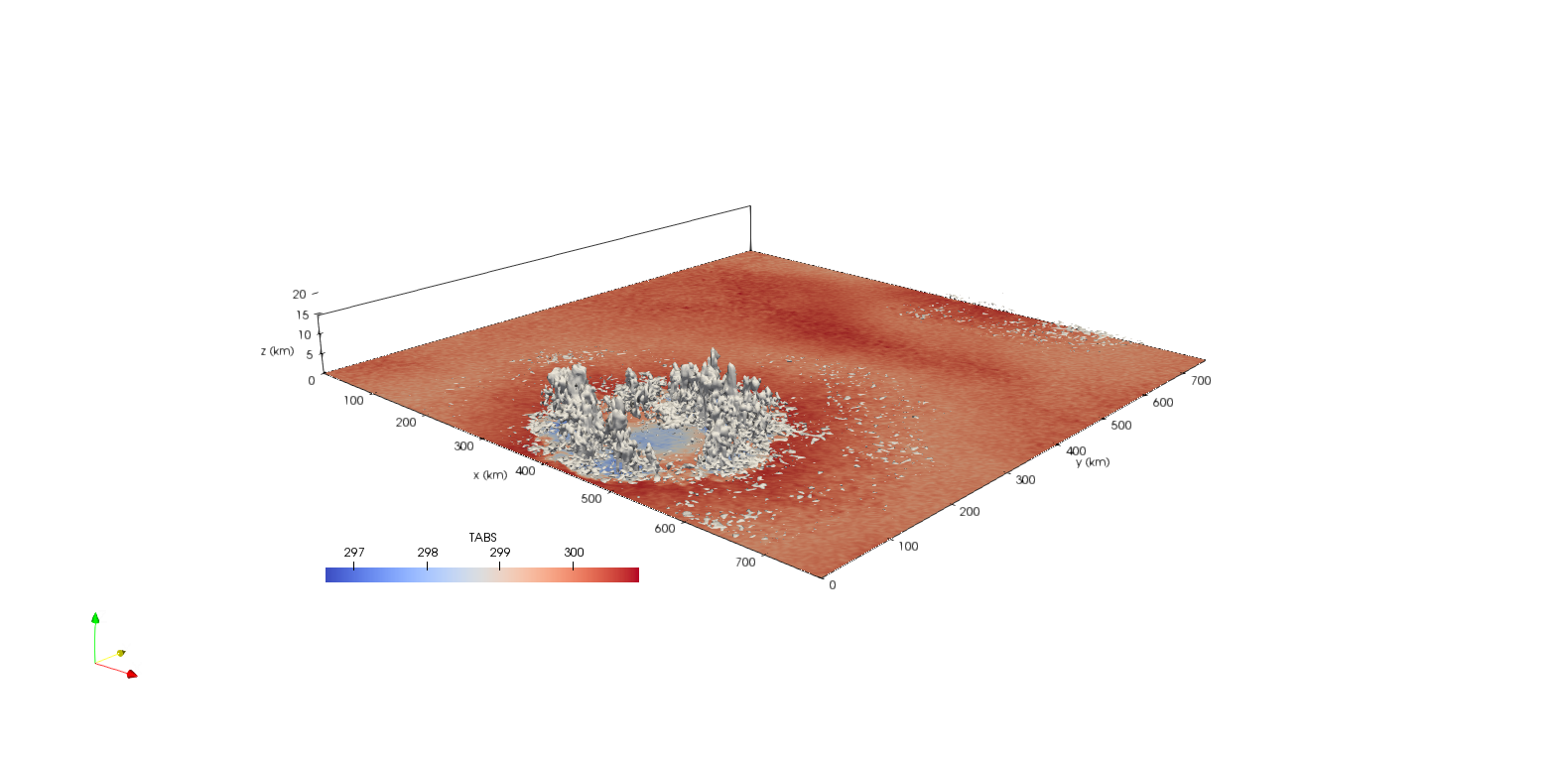
Atmospheric models are numerical models developed to predict weather and climate. The laws of physics governing all the dynamical and physical processes occurring in the Earth system (such as radiation, cloud formation, convection, turbulent motions, evaporation) are discretized on a numerical grid covering all the planet and numerically solved with high-performance computers to predict the future state of the atmosphere starting from a prescribed initial condition.
However, any forecast comes with its own degree of uncertainty. First, the knowledge of the initial state of the atmosphere will never be exact. Unfortunately, the atmosphere is a chaotic dynamical system especially on time scales of a few days. Therefore slightly different initial conditions could bring to very different future states. Second, even if we could have started different forecasts from one exact initial state of the atmosphere, the predictions would again diverge simply because of the limited digits used by computers to solve the governing equations. Finally, our forecasts are limited by the simplified representation of the physical processes governing the atmosphere, especially those occurring at very small scales (small turbulent motions, cloud microphysics, radiation processes).
The atmospheric modeling section of CRC constantly works to improve weather and climate forecasts, by enhancing the representation of physical processes and the initial conditions in atmospheric models.
Rainfall predictability in radiative-convective equilibrium states
Radiative-Convective equilibrium states (RCE) are examples of statistical equilibrium states of a convective atmosphere. We use mainly three Convective Resolving Models (CRM) in order to study such statistically stable state of convection:
- the Advanced Regional Prediction System, ARPS (http://www.caps.ou.edu/ARPS/);
- the System of Atmospheric Modeling, SAM (http://rossby.msrc.sunysb.edu/~marat/SAM.html).
- the Weather Research and Forecasting model, WRF (https://www.mmm.ucar.edu/weather-research-and-forecasting-model).
Such models are used to perform idealized experiments on the development and structural organization of convection in environments at radiative-convective equilibrium. These idealized experiments are modeled, as other similar experiments to study the aggregation of convection and its variability. The aim of these experiments, while studying the robustness of the statistical states of equilibrium given the different prognostic variables used by the models, is to assess the sensitivity to different physical parameterizations for turbulent fluxes, mixing and radiation used as model forcing to simulate the effect of moisture and temperature on the convection dynamics and the subsequent precipitation fields.
The influence of orography on rainfall variability
The orographic control of precipitation is associated with both dynamic and thermodynamic mechanisms responsible for rainfall enhancement in the presence of mountains. First, we use observations in order to assess the orographic control of precipitation particularly in Central Italy, where rainfall variability is strongly influenced by the presence of Apennines mountains. Second, we use high-resolution models (SAM, ARPS, WRF) with both idealized and real terrain configurations in order to investigate the role of orography on the dynamics of convective precipitation.
Atmospheric modeling and weather forecasts in Central Italy
We use high resolution models in order to study real cases of particular and extreme weather events in Central Italy. This is made in collaboration with CETEMPS (Center of Excellence Telesensing of Environment and Model Prediction of Severe events, http://cetemps.aquila.infn.it/) and thanks to the data and high-performance computing resources made available by the ECMWF (European Centre for Medium-Range Weather Forecasts, https://www.ecmwf.int/) and by the computing facilities of the Civil and Environmental Engineering Department (DICA) of University of Perugia.

2021 – Programma d’intervento per l’analisi della rete meteorologica umbra e suo adeguamento agli standard internazionali. This project has been founded by Umbria regional authorities. In particular, the atmospheric modeling section of CRC, in collaboration with HIMET(http://www.himet.it/it/)-CETEMPS has outlined a regional strategy in order to develop an integrated modeling system to provide reliable weather forecasts in central Italy.
2018 – Open-IFS Project. The CRC is among the licensed institutions (https://confluence.ecmwf.int/display/OIFS/OpenIFS+licensed+institutions) of the Open-IFS project (https://confluence.ecmwf.int/display/OIFS). OpenIFS provides research institutions with an easy-to-use version of the ECMWF IFS (Integrated Forecasting System). Currently we use this model to perform idealized experiments of Radiative-Convective Equilibrium.
2010 – African Monsoon Multidisciplinary Analysis (AMMA)
The University of Perugia took part as partner in the AMMA project to investigate the role of the African monsoon in determining the global climate and the future of West Africa. The project produced important results on the influence of the monsoon on the formation of Atlantic hurricanes and on local impacts on disease and food crises in Sahelian Africa.
Publications
Cerlini, P. B., Saraceni, M., & Silvestri, L., Competing effect of radiative and moisture feedback in convective aggregation states in two CRMs. Journal of Advances in Modeling Earth Systems, 15, e2022MS003323. https://doi.org/10.1029/2022MS003323, (2023).
Silvestri, L., Saraceni, M., & Bongioannini Cerlini, P., Links between precipitation, circulation weather types and orography in central Italy. International Journal of Climatology, 1– 19. https://doi.org/10.1002/joc.7563, (2022).
P.B. Cerlini, F. Cotana, F. Rossi, F. Asdrubali, Numerical Modeling of Atmospheric Water Content and Probability Evaluation. Part II, Procedia Engineering, Volume 70, Pages 330-338, ISSN 1877-7058, https://doi.org/10.1016/j.proeng.2014.02.037, (2014).
P.B. Cerlini, F. Cotana, F. Rossi, F. Asdrubali, Numerical Modeling of Atmospheric Water Content and Probability Evaluation. Part I, Procedia Engineering, Volume 70, Pages 321-329, ISSN 1877-7058, https://doi.org/10.1016/j.proeng.2014.02.036, (2014).
Taylor, C.M., Parker, D.J., Kalthoff, N., Gaertner, M.A., Philippon, N., Bastin, S., Harris, P.P., Boone, A., Guichard, F., Agusti-Panareda, A., Baldi, M., Cerlini, P., Descroix, L., Douville, H., Flamant, C., Grandpeix, J.-Y. and Polcher, J., New perspectives on land–atmosphere feedbacks from the African Monsoon Multidisciplinary Analysis. Atmosph. Sci. Lett., 12: 38-44. https://doi.org/10.1002/asl.336, (2011).
Bongioannini Cerlini, P., Emanuel, K. A., and Todini, E.: Orographic effects on convective precipitation and space-time rainfall variability: preliminary results, Hydrol. Earth Syst. Sci., 9, 285–299, https://doi.org/10.5194/hess-9-285-2005, (2005).
Paolina Bongioannini Cerlini, This email address is being protected from spambots. You need JavaScript enabled to view it.
Lorenzo Silvestri, This email address is being protected from spambots. You need JavaScript enabled to view it.
Miriam Saraceni, This email address is being protected from spambots. You need JavaScript enabled to view it.


